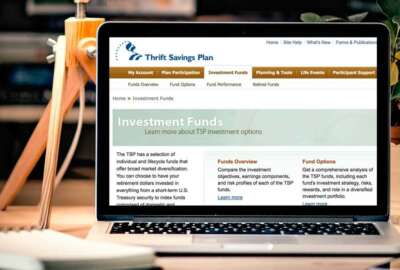Hubbard Radio Washington DC, LLC. All rights reserved. This website is not intended for users located within the European Economic Area.
TSP end-of-the-year review of your investment decisions
For Thrift Savings Plan investors, 2023 showed some positive signs. The year also brought some changes to the "I" Fund. For more, Federal News Network's workfor...
For Thrift Savings Plan investors, 2023 showed some positive signs. The year also brought some changes to the “I” Fund. For more, Federal News Network’s workforce reporter and co-host of the podcast Fed Life, Drew Friedman, talked with certified financial planner Art Stein on the Federal Drive with Tom Temin.
Interview Transcript:
Drew Friedman We know that there have been some pretty big changes to the AI fund recently. The TSP board says it’s going to improve the risk return profile. Just curious your thoughts on that. Do you think that’s accurate or what impact will this have on participants who are invested in the AI fund?
Art Stein Well, it’s definitely an improvement. The old index or the actually the current index for the I fund, not a good index, hasn’t been for many, many years. The TSP board has been trying to change it for some time and they were going to change it a couple of years ago. But the new index invested in China and Hong Kong and that was a political issue on the Hill and many Congress members protested. And so the TSP just didn’t do anything. Now they found an index or an index was created for them, which is also possible, that invests in the index that they wanted to use but excludes any Chinese stocks or Hong Kong stocks, stocks of companies based in Hong Kong. So it’s basically the same as they tried to do before. One of the reasons they needed to do this is because the I Fund the current index was so poorly constructed, performance was not as good. And because international stocks just weren’t doing as well as U.S. stocks, U.S. companies were doing better than foreign companies. You know, if you look at like the 15 year average annual rate of return, it was 6% per year for the I Fund. It was 12.5% for the C fund. That’s, you know, twice as much. So the current index only invests in developed countries and not all developed countries and only invests in the stocks of large companies. And for some reason, they excluded Canada from the list of developed countries, which I found very strange. The new index invests in twice as many countries, including a lot of developing countries, and it’s invested seven times as many stocks as the old index. If you look at the top ten holdings in the new index compared to the current index, they’re mostly the same. The three new ones are Taiwan Semiconductor, which is, you know, a great company that has a monopoly on semiconductor manufacturing, Samsung Electronics, which most people have heard of, and Toyota, which is probably everybody has heard of. And the country weights are different. They have a lot less invested in Japan, United Kingdom, France, Switzerland, countries like that. So I’m glad they’re doing this. It’s going to take place next year. The change over TSP participants, I assume, will not have to do anything. I’m pretty sure they’ll just change it. And I think people would be better off now in terms of returns. They’re really not hugely different according to what the TSP put out their press release. The average annual rate of return over the last five years for the new index would have been 4.2% compared to 3.5% for the old index. So four two is better than three five, but not a huge difference. The new index is actually, again, according to them, slightly more volatile than the old index, but not a big difference. You know, not one that I would consider significant or that anybody needs to worry about. So basically, it’s a step forward for the TSP.
Drew Friedman So Art, given that this is a pretty significant change, you know, I know that TSP participants who are currently enrolled in the I Fund, this will just transition over once that change takes place sometime in 2024. But do you anticipate or do you recommend that TSP participants maybe consider changes to their current investments, maybe invest more in the I Fund as a result of this change?
Art Stein That’s a very good question. I think people should have international stock exposure. We certainly do it for all our investment clients. But this is still a very narrowly focused fund and it’s an index fund. So it means that they have just bought these companies probably because they’re the largest in each market without any great attempt to see if they’re the best companies or they’re going to do better than other companies. And we have found that for international stock indexes, the International Stock Fund’s actively managed funds are a better bet than index funds because it’s such a huge marketplace. It’s better to have someone actually making decisions.
Drew Friedman Just speaking as well. You alluded to the political pressure that existed. I know this is something that the TSP board has been at least considering this change since 2017. So it’s been six or so years now that they’ve considered changing the I Fund. But do you think that the exclusion of Chinese investments is going to have an effect on the overall volatility or the performance of the benchmark index? Does that change things for how it will perform?
Art Stein You know, Drew, it’s a very interesting situation. You know, it’s sometimes better to be lucky than smart. And I’m not saying that members of Congress are not smart. They are. But they wanted to exclude Chinese stocks for political reasons. And, you know, I did not disagree. And it turns out that since that time, really, the Chinese market has not done well. I mean, certainly TSP participants did not lose out as a result, according to these statistics, had they been able to make the change to this new index five years ago they would have been slightly better off, but not a big difference. But whether people want to switch a higher percentage of their assets into international, you know, I answer that question for my clients all the time, but I don’t want to do it just in general, because, you know, it maybe that international stocks in general continue to lag U.S. stocks. So if people go into more into the I fund, it might reduce the volatility of their overall portfolio, but it might also reduce the returns. So that’s a decision the people either need to make themselves or they need to consult a professional to help them make.
Drew Friedman Another big topic for the TSP is the recent report on the TSP millionaires and the levels of those that are, you know, going on right now. I think it’s been actually quite a big increase since the number of TSP millionaires for 2022. Any insights into why that might be the case?
Art Stein Well, one very easy insight, Drew, is that the market went up. So one thing about TSP millionaires that I noticed and it’s not unexpected, is that people that do better are the ones that had a higher percentage invested in the stock funds, the C and the S, and the I fund than the bond funds. And they were the people that didn’t pull out when the markets crashed. But the other thing that you cannot deny is the number of TSP millionaires is very much a function of how long people have been investing. It’s just that’s the way investing is. You know, these are people didn’t worry about the ups and downs of the markets. They just believe that stocks were outperform and they’ve been working longer than the people who are not millionaires. And so they made good decisions. But then they’ve been investing for a long time.
Drew Friedman So that if that’s the case, if you’re speaking to a federal employee who might be 25, 30 years old, they’re just at the start of their career, do you recommend just kind of sticking with it or what would you say they should do to try to eventually reach that TSP millionaire status?
Art Stein Historically, you’ve been in much better off having a higher percentage in the stock funds, not pulling money out in anticipation of a market crash or because the market had crashed. We get stock market crashes. That’s a good time to be buying. And also people can be more aggressive with their biweekly investments, you know, even if they don’t want too much in stocks, it doesn’t mean that their biweekly investments shouldn’t be more heavily concentrated to go to the stock funds because they’re just putting in a smaller amounts every two weeks. And if the market goes down, they’re buying. So they kind of want the markets to go down. You need to have a long term outlook. And even for people who are getting ready to retire, remember that, you know, you can retire at 65 and easily be alive at 95. People need to have a very long term outlook on their retirement. And over 30 years, I don’t know, people don’t expect stocks to outperform over a 30 year period compared to the bond funds.
Copyright © 2024 Federal News Network. All rights reserved. This website is not intended for users located within the European Economic Area.
Drew Friedman
Drew Friedman is a workforce, pay and benefits reporter for Federal News Network.
Follow @dfriedmanWFED
Related Stories
Related Topics





